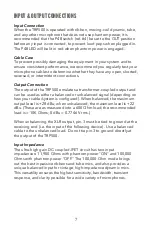
7
INPUT & OUTPUT CONNECTIONS
Input Connection
When the TRP500 is operated with ribbon, moving-coil dynamic, tube,
and any other microphone that does not use phantom power, it is
recommended that the P48 switch (ref. #4) be set to the OUT position
before any input is connected, to prevent loud pops when plugged in.
The P48 LED will be lit in red when phantom power is engaged.
Cable Care
To prevent possibly damaging the equipment in your system and to
ensure consistent performance, we recommend you regularly test your
microphone cables to determine whether they have any open, shorted,
reversed, or intermittent connections.
Output Connection
The output of the TRP500 emulates a transformer-coupled output and
can be used as either a balanced or unbalanced signal (depending on
how your cable/system is configured). When balanced, the maximum
output level is +28 dBu; when unbalanced, the maximum level is +22
dBu. (These are as measured into a 600 Ohm load; the recommended
load is > 10K Ohms; 0 dBu = 0.7746 V rms.)
When unbalancing the XLR output, pin-3 must be tied to ground at the
receiving end (i.e. the input of the following device). Use a balanced
cable to the unbalanced load. Do not tie pin-3 to ground directly at
the output of the TRP500.
Input Impedance
The ultra-high gain DC-coupled JFET circuit has two input
impedances: 11,900 Ohms with phantom power "ON" and 100,000
Ohms with phantom power "OFF." The 100,000 Ohm mode brings
out the best in passive ribbons and tube mics, and also provides a
unique balanced input for vintage, high-impedance dynamic mics.
This versatility ensures the highest sensitivity, bandwidth, transient
response, and clarity possible for a wide variety of microphones.






























